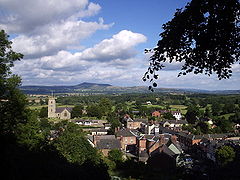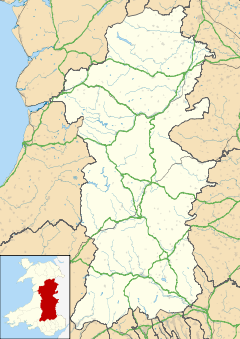- Montgomery, Powys
-
Coordinates: 52°33′46″N 3°08′57″W / 52.5628°N 3.1493°W
Montgomery Welsh: Trefaldwyn 
View across Montgomery towards Long Mynd
 Montgomery shown within Powys
Montgomery shown within PowysPopulation 1,256 (2001 census[1]) OS grid reference SO221967 Principal area Powys Country Wales Sovereign state United Kingdom Post town MONTGOMERY Postcode district SY15 Dialling code 01686 Police Dyfed-Powys Fire Mid and West Wales Ambulance Welsh EU Parliament Wales UK Parliament Montgomeryshire List of places: UK • Wales • Powys The historic county town of Montgomery (Welsh: Trefaldwyn; meaning "The Town of Baldwin") in Powys, Wales lies just three miles from the English border in the Welsh Marches. It is best known for its castle, Montgomery Castle, begun in 1223, and its parish church, begun in 1227. However its origins go back much further, as seen by the Celtic Iron age hill fort on the edge of the town. Other attractions include The Old Bell Museum, the Offa's Dyke Path, the Robber's Grave and the town wall, as well as several impressive buildings.
Even though the town has long since lost its trappings of power as a county town, there is still a bustling small commercial centre and continues to attract increasing numbers of tourists.
Contents
History
The town was established around a Norman stone castle on a crag. The castle had been built in the early 13th century to control an important ford over the nearby River Severn and replaced an earlier motte and bailey fortification at Hendomen, two miles away. An important supporter of King William I (the Conqueror), Roger de Montgomery, originally from Montgomery in the Pays d'Auge in Normandy, was given this part of the Welsh Marches by William and his name was given to the town surrounding the castle.[2]
Montgomery was sacked at the beginning of the 15th century by the Welsh Prince Owain Glyndŵr (Owen Glendower). At this time, the castle and surrounding estates were held by the Mortimer family (the hereditary Earls of March) but they came into royal hands when the last Earl of March died in 1425. In 1485, King Richard III was defeated at the Battle of Bosworth and the Royal Estates, including Montgomery and its castle, passed into the hands of the new King, Henry VII, the first Tudor king, and a Welshman. The castle was then given to another powerful Welsh family, the Herberts, in 1541.[2]
During the Civil War, the castle was captured by Parliamentary forces and subsequently slighted (damaged) to remove its military threat.[2]
As a county town, Montgomery prospered, and the consequent buildings give the small town its current character.
In 1923 the Montgomeryshire County War Memorial was completed to commemorate fallen soldiers from Montgomeryshire County. The Memorial resides 0.75 miles to the Southwest of Montgomery, on a hill overlooking the countryside.
Religious poet and orator George Herbert was born in Montgomery in 1593.
St Nicholas Parish Church, Montgomery
The parish church was founded in the first half of the 13th century, though the church has continued to change throughout the ages. Perhaps the most remarkable feature of the church is the ornate rood screen, misericords and stalls which were transferred to the church from Chirbury Priory in Shropshire after the Dissolution of the Monasteries in the 16th century. The south transept shows evidence of Montgomery's close association with the Herbert family. The centrepiece is the Elizabethan era tomb or church monument to Richard Herbert of Montgomery Castle, father of poet and Anglican divine George Herbert. This association is recalled in a memorial poem to a well-known local man JDK Lloyd, who wrote the following poem after the style of George Herbert:-
This O, enclosed around, smoothe, with no entrance found, yet soone with newest life to overflow So has thy tombe, by Pilate sealed, to us that third day Life revealed, O grant that I, some morning bright, my earthly Shell, then broke, may wear, in White, Thy Yoke.
Richard Herbert, 2nd Baron Herbert of Chirbury, the last Herbert to have lived at Montgomery Castle, was buried in the church in 1655.[3]
Montgomery Primary School
The current school was established in 1865 with land donated by Lord Powis and monies from the then Rector, the Hereford Diocesan Board of Education as well as many smaller gifts. The school remains an important feature of community life. It remains a church school (now the diocese of St. Asaph) under the control of Powys County Council.[1]
Robber's grave
In 1821 John Davies of Wrexham was sentenced to death by hanging at Montgomery for highway robbery. Throughout his trial, and after the sentence, Davies declared his innocence and prayed that God would not allow the grass to grow on his grave for a hundred years as a sign of his innocence. His grave remained bare for at least a century, giving birth to the legend of the Robber's grave. The grave (now grassed) can still be seen in the churchyard.[4]
References
- ^ Office for National Statistics Parish Headcounts: Montgomery
- ^ a b c "A History of Montgomery". 2004. http://www.montgomery-powys.co.uk/history_.htm. Retrieved 14 Apr 2009.[dead link]
- ^ W. R. Williams, The parliamentary history of the principality of Wales, from the earliest times to the present day, 1541-1895 (1895), p. 143
- ^ The Robber's Grave
External links
- Montgomery-Wales
- Montgomery-Powys
- 'The Robber's Grave' story
- Montgomery Church in Wales primary school website
- Ann & John Welton 'The Story of Montgomery' Logaston Press 2003
- BBC Wales on Montgomery
- Ivyhouse Tearooms
- The Dragon Hotel and Restaurant with Swimming Pool
- www.geograph.co.uk : photos of Montgomery and surrounding area
Categories:- Towns in Powys
- Welsh county towns
- Towns of the Welsh Marches
Wikimedia Foundation. 2010.


